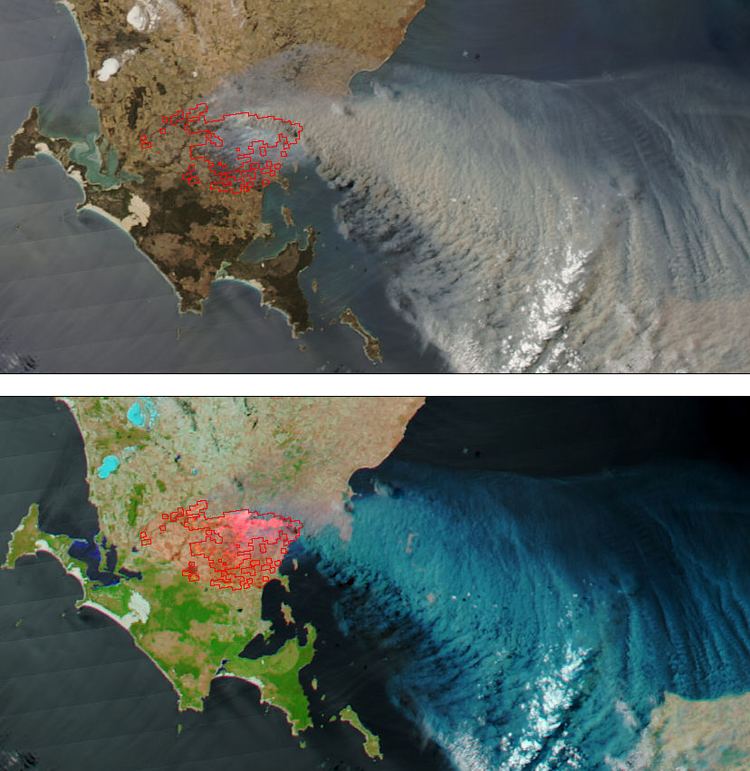Cost $28 million AUD (2005) Injuries 110 civilians | Buildings
destroyed 79 | |
 | ||
Location Lower Eyre Peninsula, South Australia, Australia Date(s) January 10, 2005 (2005-01-10) – January 20, 2005 (2005-01-20) Burned area 820 square kilometres (202,626 acres) | ||
Eyre Peninsula bushfire was a bushfire which occurred during January 2005 on the lower part of the Eyre Peninsula in the Australian state of South Australia with the result of 820 square kilometres (320 sq mi) of land being burnt, the loss of nine lives and injury to another 110 persons. It was one of Australia’s worst bushfires since the Ash Wednesday fires of 1983.
The bushfire began in farmland north of the town of Wangary and spread to the east. Investigation confirmed that the cause was a faulty muffler on a vehicle parked in grass on a roadside by a man checking the suitability of an area for prospecting with a metal detector. investigations confirmed that it was not arson. It burnt more than 820 square kilometres (320 sq mi) of farm and scrubland in and around the small townships of Wangary, Wanilla, North Shields, Poonindie, Louth Bay, Greenpatch, and Yallunda Flat to the north of the city of Port Lincoln.
More than $100 million los included 79 houses completely destroyed, 26 houses suffering extensive damage, 139 vehicles destroyed, 324 sheds destroyed or severely damaged, 138 farm implements destroyed, 6.300 km of fencing destroyed, 46,500 head of stock killed, one aircraft ($100,000) destroyed, tools and equipment of 46 small businesses/contractors lost. This does not include the human impact of loss, injury and dislocation, or the loss of possessions, clothing, even school books before the new school year about to resume.
1,290 people suffered loss of property because of the fire.
The bushfire was later called the "Black Tuesday" fires as it resulted in much damage to property and even more damage to locals' lives. The fire began on 10 January, and was initially contained by emergency services. However, severe weather conditions on 11 January, with wind speeds of 70 km/h and temperatures exceeding 40 degrees, then caused the fire to break through containment lines and spread to the east.
More than 400 South Australian Country Fire Service (CFS) fire fighters and 80 fire appliances combated the bushfire, with assistance from local property owners. The Port Lincoln Airport was temporarily closed, preventing additional fire fighters from being flown in from Adelaide. A major emergency was declared for the Eyre Peninsula from noon on 12 January until 16 January.
As the bushfire tore through North Shields, a small settlement north of Port Lincoln, residents were ordered to leave their homes and head to the beaches to the east. The bushfire raged through the caravan park at North Shields, destroying cabins and caravans. Residents at Louth Bay were forced to evacuate and seek refuge on nearby beaches. Some residents had to be rescued from the sea by emergency services after taking refuge in the water.
Six people, including four children, died in their cars as they tried to flee the firestorm. Two others died when the vehicle from which they were fighting the fire was engulfed by flame. A local schoolteacher also died when flames engulfed the Shell Museum at North Shields north of Port Lincoln. 113 were reported injured, including five who suffered serious burns and were flown to Adelaide for treatment. Several people were treated at Port Lincoln Hospital for burns and smoke inhalation. The fire was contained on 12 January after burning for two days.
Property damage included 15 caravans, two buses, three cabins, one shop, three vans and four boats. There was also extensive damage to rural infrastructure, including water mains, power lines and telephone infrastructure.
Recovery effort
Even as the bushfire continued its spread across the peninsula, residents came together to provide emergency accommodation and assistance for fire victims at several assembly points. Many had been feeding firefighters then as the dire need of families became known the role adopted by many people became one of immediate relief to fire victims. Relief centres were established at Port Lincoln High School and Cummins Bowling Club.
Two days after the bushfire was contained, and continued to burn, the South Australian Government established the West Coast Recovery Committee to oversee all aspects of the recovery effort. Vince Monterola, a former CEO of the CFS, and then Fire and Emergency Commissioner was appointed chairman. He appointed a leadership team of 9 people, each assigned a specific area of responsibility - accommodation, infrastructure, health, welfare, logistics, counseling, farm services, emergency services, and communication. Amongst benefits and support provided by the government, a grant of $10,000 was provided to all farmers affected by the fire to assist with immediate needs.
